Professor Alexandr Bazhin, born 1975, came to Germany from Moscow to make an international academic career in clinical cancer research. He used to be postdoc till he was appointed adjunct professor at the German Cancer Research Centre (DKFZ) in Heidelberg, and is now affiliated with the thoracic surgery department of the Munich University LMU. Bazhin is also a coach for career success, his speciality is “lifelong learning for personal success“.
But sometimes, even renowned experts and educators like Professor Bazhin can learn something. Here, from Elizabeth Bik, the famous image integrity sleuth. She namely had a look at Bazhin’s papers, and some of those prompted her to go to PubPeer to share her findings.
Bazhin studied in Moscow and did PhD in the lab of Pavel Philippov, at the Lomonosov University. This was their common paper from 2001, which the eagle-eyed Bik flagged years ago:
Alexandr V. Bazhin, Olga N. Shifrina, Marina S. Savchenko, Natalya K. Tikhomirova, Maria A. Goncharskaia, Vera A. Gorbunova, Ivan I. Senin, Alexandr G. Chuchalin, Pavel P. Philippov
Low titre autoantibodies against recoverin in sera of patients with small cell lung cancer but without a loss of vision, Lung Cancer (2001) doi: 10.1016/s0169-5002(01)00212-4
Apparently, Bik reported her findings to the Elsevier journal Lung Cancer in 2015, but “no action was deemed needed”. She seems to have also reported another paper co-authored by Bazhin:
Marina S. Savchenko, Alexandr V. Bazhin, Olga N. Shifrina, Sofia A. Demoura, Eugenia A. Kogan, Alexandr G. Chuchalin, Pavel P. Philippov
Antirecoverin autoantibodies in the patient with non-small cell lung cancer but without cancer-associated retinopathy Lung Cancer (2003) doi: 10.1016/s0169-5002(03)00239-3
This time, an Expression of Concern was issued, but it is extremely well hidden, not just behind a paywall ($35.95 to read). Of course it is not linked to the original article, anywhere. Only Bik, who knew in which Lung Cancer issue (November 2016 Vol 101, Page 145) to look for the expression of concern, was aware. Nothing has happened since, which is not really surprising.
The notice went, signed by Philippov:
“The Editors of Lung Cancer wish to alert readers of the journal to potential errors in Fig. 1A of the above-referenced article. A reader of the journal contacted the Editors and expressed concern about irregularities pertaining to the figure. The authors have confirmed that the figure was prepared by photographing the blots as scanning equipment was not available with in their institution. The authors believe that lines 3 and 7 may have been duplicated by accident during the preparation process. The authors report that the project was closed in 2004 and the original data pertaining to this article has now been destroyed.”
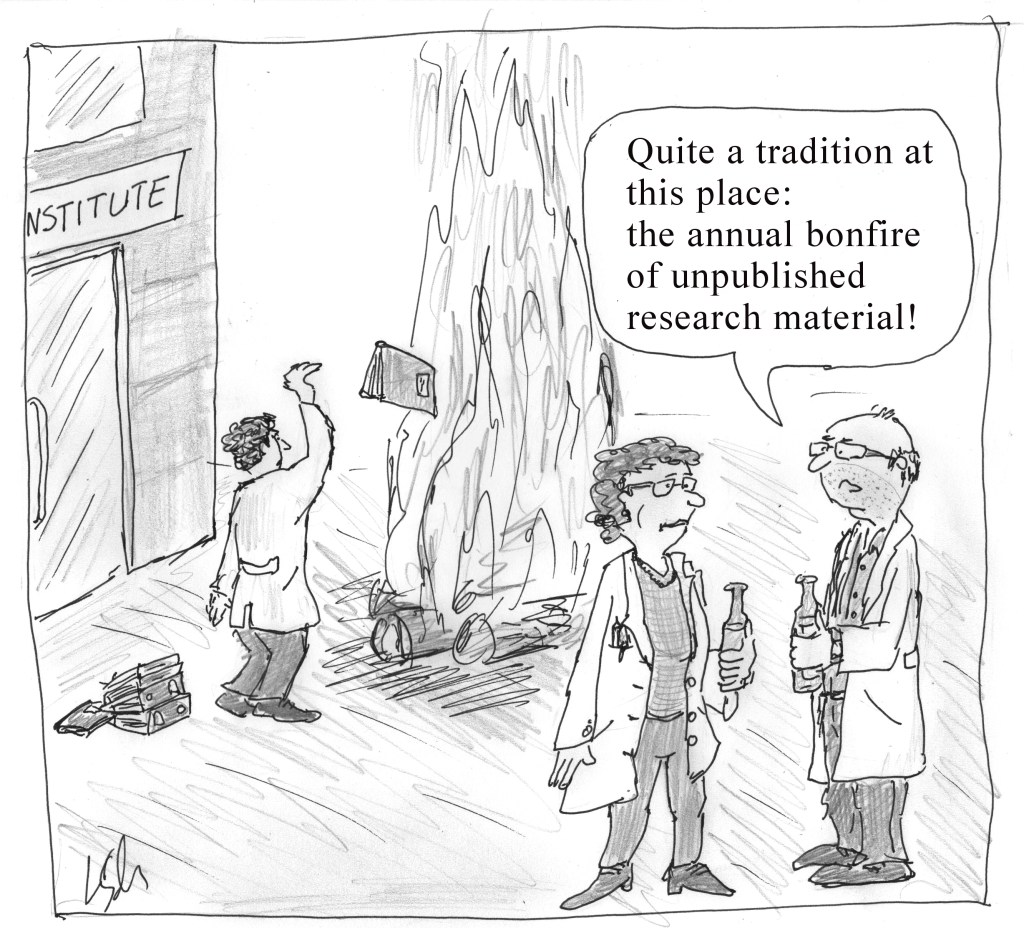
Somewhere at the time of the Moscow Festival of Data Bonfire (an traditional local festivity to celebrate a successful publication in a peer reviewed journal), Bazhin moved to Germany to do postdoc. There he joined in the lab of Stephan Eichmüller, professor at DKFZ and specialist for T cell therapy. DKFZ is a very well financed German research institution, this is why they were perfectly able to afford Professor Eichmüller’s trip to an OMICS conference in 2015, OMICS being the infamous predatory publisher and scamference organiser.
With Eichmüller as his last author, Bazhin the corresponding author issued this interesting study:
Alexandr V. Bazhin, Vojtech Tambor, Boyan Dikov, Pavel P. Philippov, Dirk Schadendorf, Stefan B. Eichmüller
cGMP-phosphodiesterase 6, transducin and Wnt5a/Frizzled-2-signaling control cGMP and Ca(2+) homeostasis in melanoma cells Cellular and molecular life sciences : CMLS (2010) doi: 10.1007/s00018-009-0214-0
Presumably that all is fine, because that paper’s last author and OMICS conference speaker Eichmüller is actually a certified expert for research integrity. He is namely Ombudsman for Good Scientific Practice at DKFZ, which kind of makes it case closed. Not for everyone though: A certain Hoya Camphorifolia chimed in, wondering if the western blots really had to be spliced in that peculiar manner:
Bik found even more reason to criticise Bazhin’s unorthodox approach to melanoma therapy, which transcends papers 4 years apart:
This is the Karakhanova et al 2014 paper, its last author is the former University of Heidelberg surgery professor Jens Werner, Bazhin current boss. Werner recently moved to Munich to become clinic head at the LMU, and took Bazhin with him, mightily impressed by the Russian’s scientific skills.
Svetlana Karakhanova, Marina Golovastova, Pavel P. Philippov, Jens Werner, Alexandr V. Bazhin
Interlude of cGMP and cGMP/protein kinase G type 1 in pancreatic adenocarcinoma cells Pancreas (2014) doi: 10.1097/mpa.0000000000000104
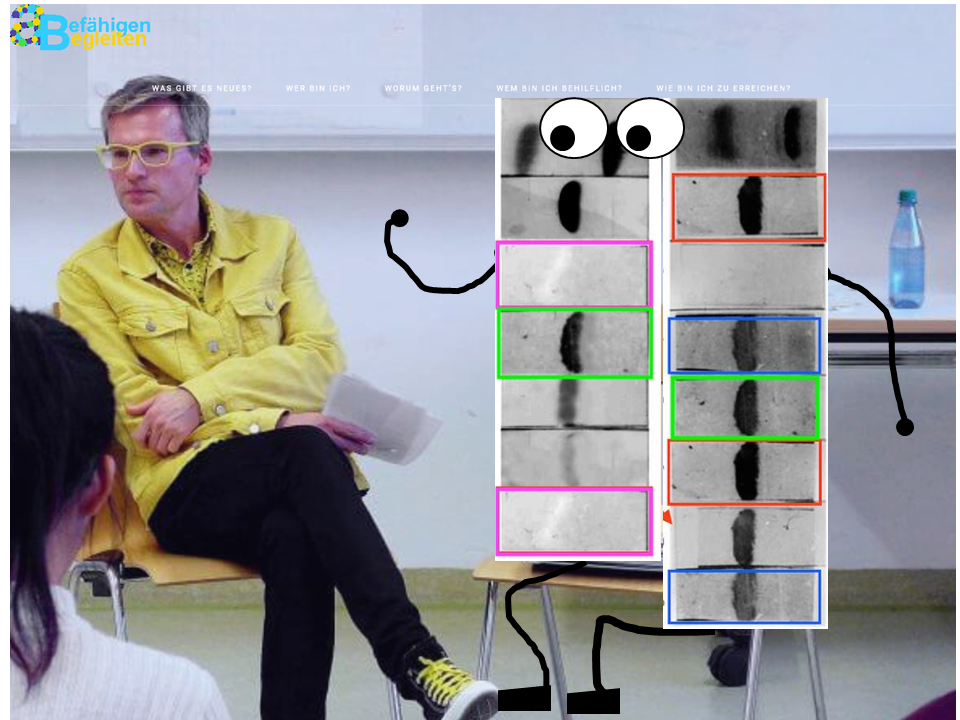
Do you think there is anything wrong with those papers? Elsevier didn’t think so, and who are we to question them. The neighbouring University of Heidelberg and its clinic also have their own rather liberal views on ethics, in fact they even educated Karolinska in Macchiarini affair. The Heidelberg Medical School has bigger fish to fry these days, what with the dean himself embroiled in a scandal of fake cancer biomarker test.
Anyway, these are just 4 out of Professor Bazhin’s currently 88 publications. In German medicine, research output is counted in hundreds of papers. Maybe Professor Bazhin is interested in meeting his German thoracic surgery colleague Professor Thorsten Walles, to discuss the art of figure assembly?
Update 26/27.09.2019
I received a reply from DKFZ and two of their 4 Ombudspeople. An investigative committee will be set up, Eichmüller will not be a member, I was told.
This email I received in cc from Klaus Eichmann, EiC Cellular and Molecular Life Sciences (CMLS):
“Dear Prof. Bazhin,
by the email below it has been brought to my attention that several figures in the above mentioned paper, of which you are the first and corresponding author, contain manipulated/duplicated gels. Please see for yourself. As the manipulations are fairly obvious, I suggest that you retract the paper.
A retraction should be published in CMLS without delay. I am looking forward to your earliest reply. “
Update 14.10.2019
Ina Wiest, legal officer at DKFZ, wrote to me on 7.10.2019:
“The article CMLS “cGMP phosphodiesterase 6, transducin and Wnt5a / Frizzled-2 signaling control cGMP and Ca (2+) homeostasis in melanoma cells” will be retracted – so it was agreed between the editor and the authors in the meantime.
Professor Stefan Eichmüller has relinquished the position of the Ombudsperson and member of the commission for the investigation of scientific misconduct. For this step, we expressly declare our respect for him. He takes over the responsibility as the last author, although he was credibly not involved in the figure assembly.”
I then asked the DKFZ to explain why their own Ombudsman Eichmüller participated in an OMICS conference in 2015. Wiest educated me on 9.10.2019:
“Although the issue of pirated publications has increasingly been the subject of public debate since 2015, the journals of the publisher “Omics Group” were indexed by SCOPUS until 2017. https://www.the-scientist.com/the-nutshell/scopus-dumps- omics-journals-31,766th
Indexing was considered a quality feature. In the mentioned period, it could happen in regrettable individual cases that scientists considered both the magazines and their conferences to be serious.
See the statement of the Helmholtz President from 2018. https://www.helmholtz.de/ueber_uns/die_gemeinschaft/standpunkte/predatory_journals_predatory_publishers/
Since last year, the employees of the DKFZ Central Library have been training our scientists about the scientific publishing industry and in particular on the traps associated with “Predatory Publishing” and “Predatory Conferences” and, in cases of doubt, also undertake the critical review of individual providers.”
Apparently until 2018, publishing in OMICS and attending predatory OMICS conferences was considered as perfectly good scientific practice at DKFZ. Despite the fact that Jeffrey Beall listed the publisher already in 2012 on his “Beall’s List”, or even in 2011 (as Beall himself told me).

Donate!
If you are interested to support my work, you can leave here a small tip of $5. Or several of small tips, just increase the amount as you like (2x=€10; 5x=€25). Your generous patronage of my journalism, however small it appears to you, will greatly help me with my legal costs.
€5.00



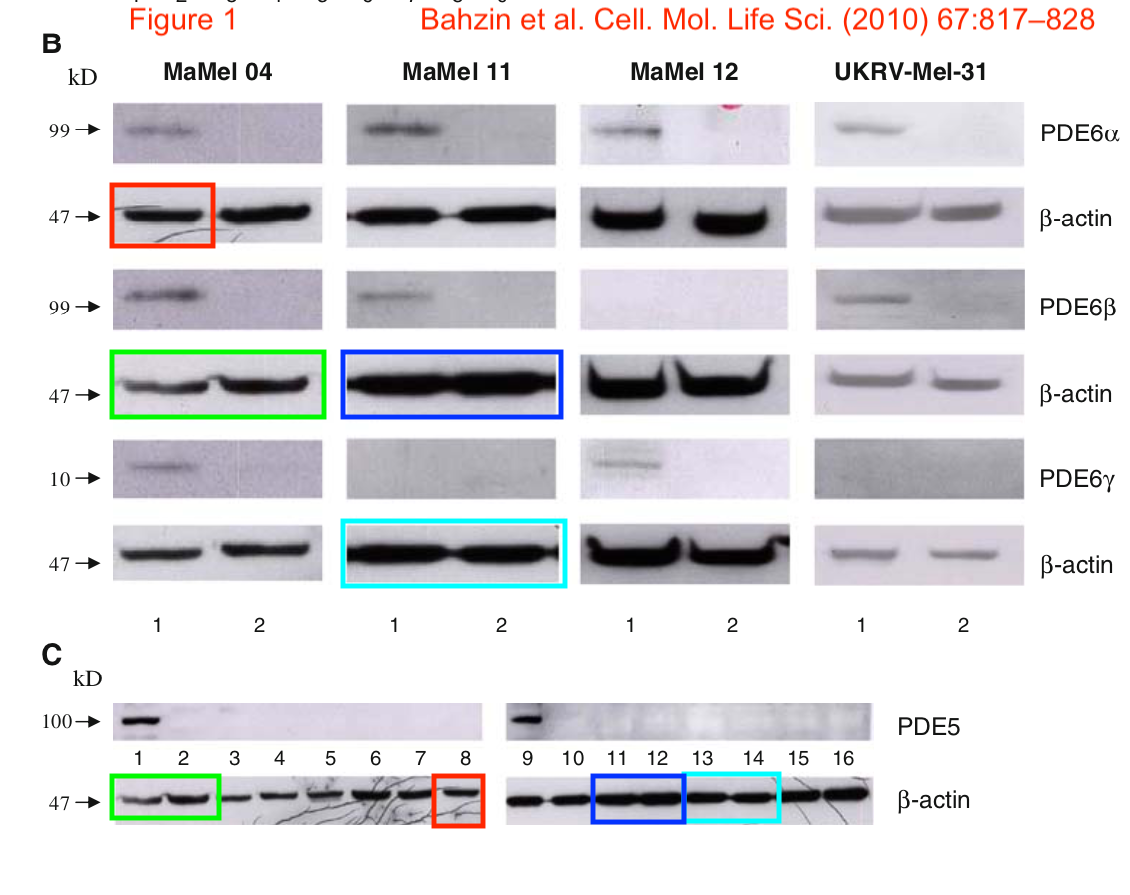
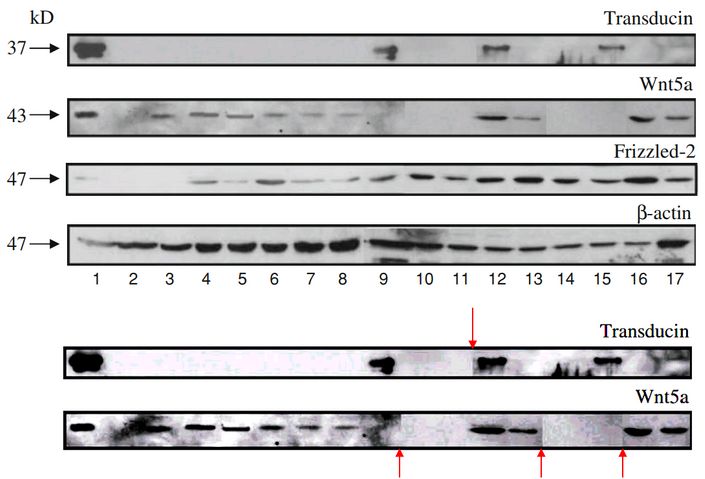
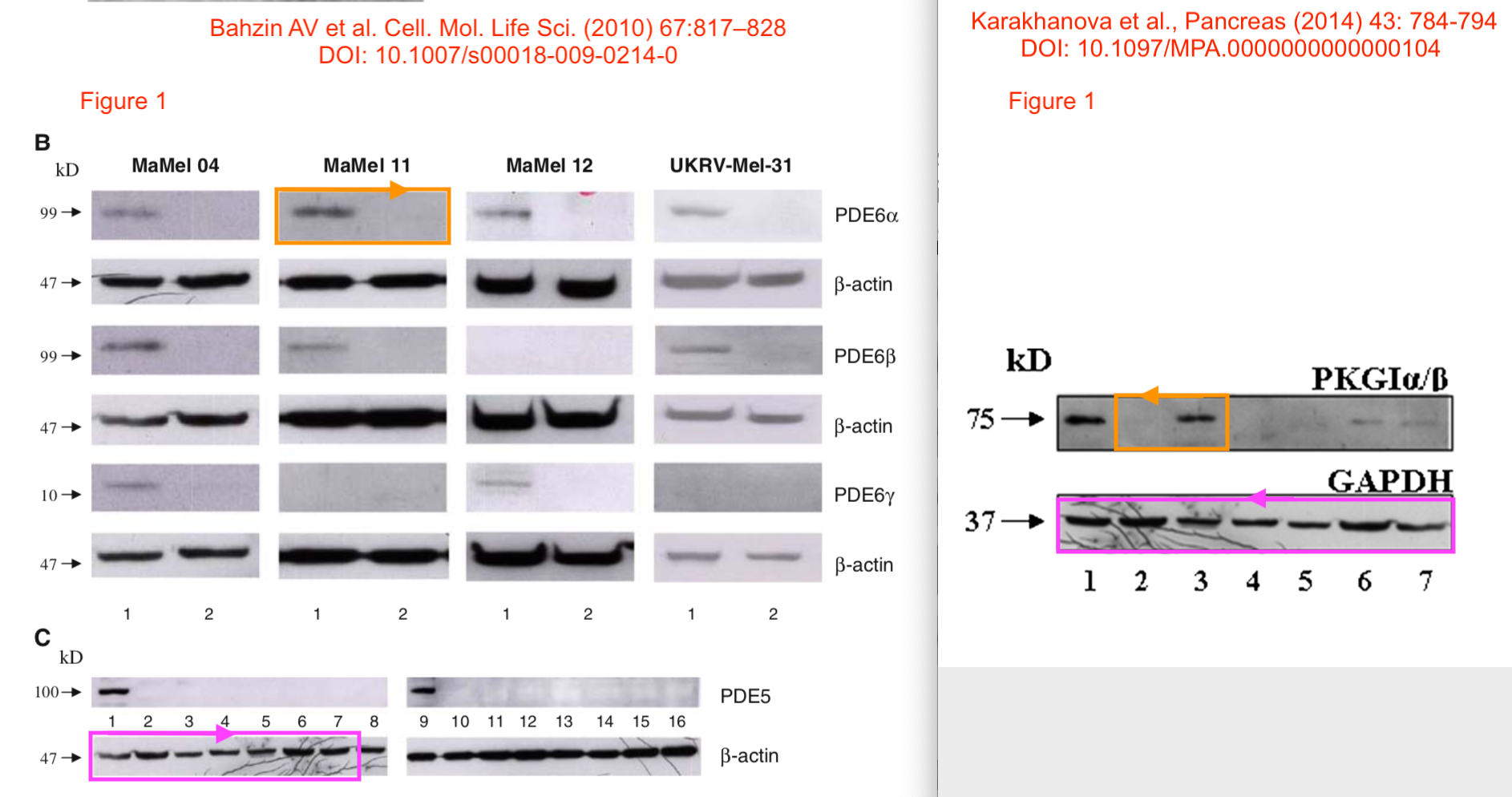

Since the b-Actin and Frazzled-2 bands are both at 47 kDa, I deduce that they came from different gels. This would explain why they follow different profiles… the Actin band has the cusp between lanes 8 and 9 (two separate gels spliced together?) while in the case of Frazzled-2, the cusp is between 9 and 10.
The other bands, though, they’re just patchworks.
LikeLike
There is more splicing, I am not sure I found all. A western blot chamber usually has either 10 or 15 lanes, one is used for the molecular weight marker.

LikeLike
You may have jumped the gun with the Photoshop accusation. These are so bad that we may be looking at good old fashioned scissors and tape collages. Possibly even of photocopies in some cases. Not a big surprise that journals with such poor production standards are not fussed by a bit of fakin’.
LikeLike
This is bad !
LikeLike
But he looks cool in yellow, so that will appeal to the European academia elite and rock stars, and the star that I predict will tell him he’s great will be none other than Chris Martin.
You want to see who else wears yellow well? Fred Schneider:
Quite frankly, I think Alexandr should be underground like a wild potatoe……
LikeLike
Either you are extremely stupid or cold-blooded psychopath to publish so damn obvious falsifications.
How can Bazhin be a scientist if he cannot even cheat properly?
LikeLike
Pingback: My little PubPeer saga – A wake-up call, by Ingrid Herr – For Better Science